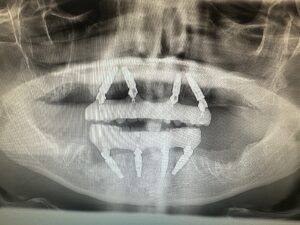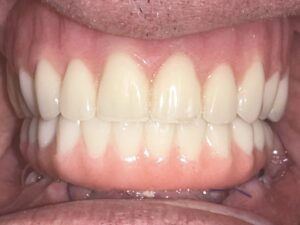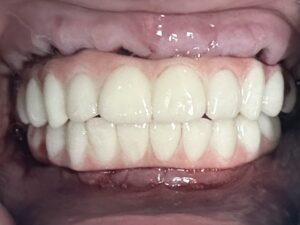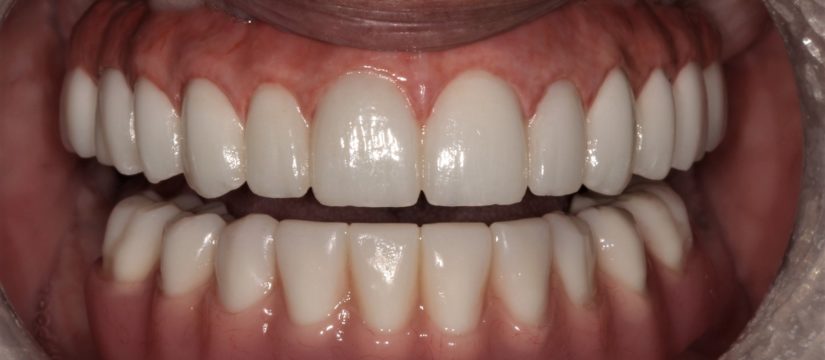
Curious about the all for 4 dental implant method? This technique relies on four implants to secure a full arch of prosthetic teeth, potentially reducing the need for complicated surgeries like bone grafting. Our article demystifies the All-on-4 approach, equipping you with the knowledge on whether it’s a good match for your dental health and full-arch restoration goals—without overselling or asserting a one-size-fits-all answer.
Key Takeaways
- The All-on-4 treatment concept is a minimally invasive solution offering full-arch teeth replacement on four implants, providing immediate fixed rehabilitation and reducing the need for bone grafting.
- All-on-4 leverages precision in implant surgery and the strategic use of tilted implants to improve bone density and support, enhancing stability and long-term success with high patient satisfaction.
- The cost of the All-on-4 procedure varies based on numerous factors, but financing options exist to make it more accessible, while alternatives like overdentures or zygomatic implants may suit those unsuitable for All-on-4.
Understanding the All-on-4 Treatment Concept
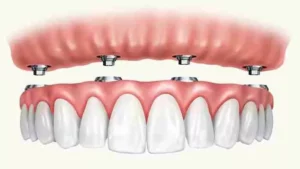
The effectiveness of the All-on-4 treatment is marked by its simplicity and precision. The treatment involves:
- Placing a fixed bridge on top of four dental implants
- Angling the posterior implants for optimal support
- Maximizing the use of available bone and bypassing the need for bone grafting
- Offering a swift and less invasive treatment option compared to conventional dentures.
The Science Behind Implant Placement
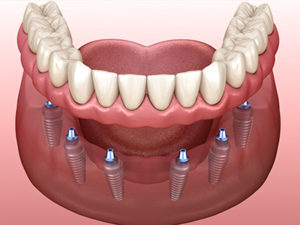
We will explore the importance of precision in implant surgery, focusing on axial and tilted implants, and the role of tilted implants in improving bone density.
Precision in Implant Surgery
In the world of implant dentistry, precision is paramount. The All-on-4 method hinges on meticulous implant site preparation, low-torque implants, and the creation of an osseous shelf to even out the alveolar ridge, which aids in optimal implant positioning. These measures reduce strain to the crestal bone by increasing the antero-posterior spread and maximizing the number of implants placed in biomechanically compromised environments.
However, the pursuit of precision extends beyond this. Surgical guides are employed in the All-on-4 concept to assist surgeons in the accurate positioning, angulation, and emergence of the implants, thereby enhancing treatment predictability. This attention to detail is what sets the All-on-4 treatment apart, ensuring that every step of the implant surgery is carried out with the utmost care and precision.
Tilted Implants and Bone Density
An intriguing feature of the All-on-4 treatment is the use of tilted implants. These implants are placed at an angulated position to maximize contact with available bone and bypass anatomical structures. This innovative approach helps avoid the need for additional procedures such as bone grafts or sinus lifts, making the treatment more straightforward and less invasive.
But the benefits of tilted implants go beyond simplifying the procedure. They enable:
- The placement of longer implants, leading to improved prosthetic support and more effective utilization of available bone
- Improved anchorage in the bone, enhancing the stability of the implanted prosthesis
- Reducing the length of the cantilever arms, which is also a benefit of angled implants
This strategic placement, combined with the design of angled abutments, helps distribute stresses evenly across the arch, maintaining stress and strain within physiological limits to preserve bone integrity.
Analyzing Treatment Outcomes
The All-on-4 treatment concept isn’t just about innovative techniques or advanced technology; it’s about results. And the results speak for themselves. With impressive success rates, high patient satisfaction, and positive long-term outcomes, the All-on-4 treatment has proven to be an effective solution for edentulous patients or those with minimal bone loss.
Learn how long the all on 4 procedure takes.
We’ll examine the outcomes of this treatment, referencing longitudinal studies and making comparisons with conventional dentures.
Longitudinal Study Insights
Long-term studies shed light on the success and reliability of the All-on-4 treatment. They consistently report high patient satisfaction rates, underscoring improvements in:
- Phonetics
- Aesthetics
- Psychological status
- Function
A retrospective longitudinal case series study published in Clin Oral Implants Res, for instance, indicated a high cumulative prosthetic survival rate of 98.8% for All-on-4 treatments in the mandible over a follow-up period of 10 to 18 years.
Furthermore, the cumulative implant survival and success rates of All-on-4 implants themselves were revealed to be 93% and 91.7%, respectively, demonstrating the long-term reliability of the treatment for up to 18 years. While biological complications have been reported, these were relatively few and generally managed by repairing the prostheses or advising patients on care to avoid overloading. These findings, however, must be considered within the context of study limitations like sample size and methodological quality, as these factors can influence the interpretation of long-term success and reliability.
Comparing Conventional Dentures
When compared to conventional dentures, the All-on-4 treatment concept shines brightly. Traditional dentures may provide less retention and comfort during eating and speaking, making them less ideal for individuals who either cannot have implants due to insufficient bone or financial constraints.
On the contrary, All-on-4 dental implants are favored for their:
- immediate loading capacity
- improved quality of life
- predictability
- cost-effectiveness, particularly for patients with atrophic jaws.
Despite the different feel compared to traditional dentures, which may pose psychological challenges for some patients, the All-on-4 treatment has been met with high levels of satisfaction. Regular dentures may be unstable and reliant on suction, leading to potential issues such as falling out while eating or speaking. In contrast, the stability offered by All-on-4 fixed bridges eliminates these concerns, significantly enhancing the phonetic, aesthetic, psychological, and functional outcomes, and ultimately, the overall quality of life.
Patient Candidacy for 4 Dental Implants
The All-on-4 dental implant treatment is not a one-size-fits-all solution. It requires a careful evaluation of a patient’s oral health and medical history to determine their suitability for the procedure.
We will discuss how assessing natural dentition and addressing bone loss can help identify ideal candidates for this transformative treatment.
Assessing Natural Dentition
Before considering All-on-4 dental implants, an important step is the evaluation of a patient’s natural teeth. Tooth extraction for All-on-4 implants is necessary when natural teeth are either too damaged or decayed to be saved, or in cases where they would interfere with the placement of the implants. Candidates for All-on-4 dental implants can have various states of natural dentition – they may not always be missing an entire arch of teeth.
While the extraction process prepares the patient for the implant-supported prosthesis, it also adds to the overall cost of the All-on-4 procedure. The expenses can vary based on the complexity of extractions and the potential need for bone grafting. Therefore, a thorough assessment of natural teeth is crucial in the preparation phase of the treatment process.
Addressing Bone Loss
Bone loss in the jaw can often be a hurdle for patients seeking dental implants. However, the All-on-4 treatment offers a ray of hope for such patients. Bone grafting can improve jaw bone density to support All-on-4 implants for patients who might otherwise not qualify due to insufficient bone density or gum tissue.
The All-on-4 treatment is tailored to maximize the use of available bone in patients with bone loss, reducing the need for bone grafting. It has proven to be a predictable option for the atrophic jaw, providing a non-regenerative alternative that maintains bone mass and stability. However, it’s important to note that some patients may require extractions or bone grafts prior to receiving All-on-4 dental implants, which can affect both the cost and recovery timeline.
The Procedural Journey
The All-on-4 dental implant procedure is a journey, with each step playing a crucial role in the overall success of the treatment. From the initial consultation to the post-operative recovery, it’s important to understand each stage of this journey.
We will review the immediate rehabilitation steps and the recovery process that occur after the implant surgery, a type of surgical procedure, for patients undergoing treatment.
Immediate Rehabilitation Steps
One of the key advantages of the All-on-4 treatment is its immediate loading capacity. The Immediate Function protocol allows for placement of provisional teeth on the same day of surgery, leveraging the All-on-4 concept that maximizes the use of available jawbone to avoid regenerative procedures. This approach has gained popularity due to its high survival rates and a low incidence of complications, demonstrating a welcomed degree of reliability in the field of implant dentistry.
Following surgery, the placement of the All-on-4 prosthesis is rigorously tested in the mouth. The timing for immediate loading protocols varies from the same day to 48 hours after surgery, with the fixed temporary bridge designed to replace regular dentures immediately. To ensure the longevity of the All-on-4 prosthesis and minimize bone loss, meticulous occlusal adjustments are made to achieve bilateral occlusion, mainly in the area of the canines and first premolars, while avoiding contacts toward the distal end of the prosthesis.
Managing Expectations and Recovery
Recovery from the All-on-4 dental implant procedure is a critical aspect of the treatment journey. Here are some important points to keep in mind during the recovery process:
- Post-operative swelling peaks within 72 hours and can be managed by using cold packs and keeping the head elevated.
- Discomfort and pain are common after the procedure, but they typically subside over the course of a few weeks.
- Medication may be prescribed to help manage pain and discomfort during the recovery period.
- It is important to attend follow-up appointments with your dentist to ensure proper healing and to address any concerns or issues that may arise.
During the first few weeks post-surgery, patients should consume liquids and soft foods while avoiding hard and spicy items to aid healing. Long-term maintenance of All-on-4 implants involves brushing and using a water flosser to clean the bridge and gum area. Understanding what to expect during the recovery process and managing these expectations can significantly contribute to a smoother and more comfortable healing journey.
Financial Considerations
The All-on-4 dental implant treatment is undoubtedly an investment. While it promises transformative results, it’s crucial to consider the financial implications. We will examine the financial aspects of this procedure, from understanding the treatment costs to exploring available payment plans.
Understanding Treatment Costs
Embarking on the All-on-4 treatment journey involves a financial commitment. The average cost of All-on-4 dental implants in the United States ranges from $24,000 to $38,889 for one arch, and a full mouth can cost approximately $50,000 to $75,000. This cost includes the implants, abutment, and implant crowns. Factors such as the brand and quality of teeth, dental materials chosen for the prosthesis, dentist’s experience, and geographic location can cause variations in the cost of All-on-4 dental implants.
While dental insurance may not cover the full cost of All-on-4 dental implants, it often contributes to the expenses of preparatory procedures. Some dental practices have benefits coordinators to help patients maximize their insurance benefits. Furthermore, patients can reduce their costs by:
- Researching different dentists
- Requesting detailed treatment plans
- Adhering to the treatment schedule
- Keeping regular dental visits
- Not missing appointments.
Exploring Payment Plans
While the cost of All-on-4 dental implants can seem daunting, there are financing options available to make the treatment more accessible. Dental practices may offer monthly payment plans for All-on-4 dental implants, allowing patients to manage costs over time. In fact, the majority of patients utilize dental financing options to pay for their All-on-4 dental implant procedure.
The All-on-4 system provides pricing and treatment plan flexibility, ensuring affordability and alignment with patients’ long-term oral health goals. When considering the Life Cycle Cost of the procedure, All-on-4 dental implants offer the following benefits:
- Long-term investment
- Enhanced quality of life
- Durable and aesthetic teeth
- Value over time
Alternative Treatment Options
While the All-on-4 treatment concept has proven to be a game-changer, it’s essential to acknowledge that it may not be the right fit for everyone. For those unsuitable for the All-on-4 procedure, there are alternative dental implant treatments available. We will examine some of these alternatives, focusing on overdentures, fixed bridges, and zygomatic implants.
Overdentures and Fixed Bridges
Full-arch fixed prosthesis alternatives, including single implants, bridges, and traditional dentures, are available for those unsuitable for All-on-4 treatment. The Fixed Hybrid Bridge, for instance, consists of a metal frame complemented with fake gums and false teeth made of resin or composite materials. It’s designed to replace approximately 12 to 14 teeth per jaw, offering a solution that spans the entire arch.
An alternative to the traditional Fixed Hybrid Bridge is the Zirconia Fixed Bridge, which uses zirconia as its primary material due to its strength and durability. These alternatives provide prospective patients with a range of options, ensuring they can find a solution that best suits their unique oral health needs and preferences.
Zygomatic Implants: When to Consider
In cases where conventional implants aren’t viable, zygomatic implants offer a solution. These implants are often utilized when there is severe maxillary bone loss and are recommended for patients with insufficient bone volume for standard implants.
Zygomatic implants represent a viable treatment option, providing an alternative solution for patients who may not be suitable candidates for the All-on-4 treatment due to severe bone loss. As with any treatment option, it’s crucial to discuss this alternative with your dental professional to ensure it’s the right fit for your specific needs and circumstances, including the consideration of clin oral implants.
Customizing Your Treatment Plan
The All-on-4 treatment isn’t a cookie-cutter procedure; it’s personalized to meet each patient’s unique needs and preferences. This customization ensures that the treatment not only addresses a patient’s dental health needs but also aligns with their aesthetic desires, functional requirements, and lifestyle.
We will discuss how aesthetics and functionality influence the treatment plan and how it aligns with a patient’s lifestyle and oral health goals.
Considering Aesthetics and Functionality
Beauty and function often go hand in hand, and the All-on-4 treatment is no exception. All-on-4 dental implants are designed to resemble natural teeth, providing patients with a beautiful, natural-looking smile that enhances their facial appearance and boosts self-confidence. The porcelain crowns used in full fixed arch bridges offer a natural appearance, matching the patient’s natural teeth in terms of color, shape, and size.
Yet, aesthetics aren’t the only consideration when personalizing the All-on-4 treatment plan. Functionality is equally critical. Dental professionals weigh factors such as material properties when considering the basic functionality of the All-on-4 prosthetic, including its ability to provide proper bite alignment.
CAD/CAM technology plays a crucial role in the precise design and fabrication of the prosthetic framework for All-on-4 implants, ensuring an accurate fit and proper occlusal alignment.
Aligning with Lifestyle and Goals
The All-on-4 treatment isn’t just about solving present dental issues; it’s about aligning with the patient’s long-term oral health goals. Assessing a patient’s unique lifestyle factors, such as profession, diet, and daily activities, is critical when considering All-on-4 dental implants to ensure it complements their routine. This treatment should also align with the patient’s long-term oral health goals to provide a lasting resolution.
Accommodating patient preferences for aesthetics, like the look and feel of the implants, ensures they are satisfied and comfortable with the All-on-4 treatment. A successful All-on-4 implant treatment plan is one that aligns with the patient’s lifestyle and oral health goals, ultimately leading to heightened satisfaction and well-being.
Summary
The All-on-4 dental implant treatment is more than a dental procedure; it’s a life-changing journey that can transform your smile, your confidence, and your quality of life. From understanding the revolutionary All-on-4 treatment concept to exploring its financial considerations, we’ve delved into the world of this innovative treatment. With its precision in implant surgery, impressive treatment outcomes, and personalized treatment plans, the All-on-4 treatment offers a comprehensive solution for those seeking a permanent, secure, and natural-looking solution for missing teeth or dentures. It’s time to embrace the power of a beautiful smile with All-on-4 dental implants!
Frequently Asked Questions
What is the All-on-4 method?
The All-on-4 method involves using four dental implants to support a new set of fixed teeth, with the posterior implants tilted 45° towards the rear of the mouth for optimal placement and effectiveness. It was developed to provide immediate function and avoid the need for costly and invasive regenerative procedures.
What is the downside of All-on-4 dental implants?
The downside of All-on-4 dental implants includes the risk of potential implant failure and speech difficulties post-surgery, in addition to their high cost, which may be prohibitive for some patients. It’s important to consider these factors before undergoing the procedure.
What is the All-on-4 criteria?
The All-on-4 treatment concept involves placing two straight implants in the anterior region and two tilted implants in the posterior zone to support a full set of teeth in one day. This immediate load approach decreases time and cost for patients.
How many teeth do you get with All-on-4?
With the All-on-4 technique, you can get a fixed dental prosthesis containing 10 to 14 teeth supported by four titanium posts. The posterior Nobel BioCare dental implants are placed at a 45-degree angle to support each denture.
Who is an ideal candidate for the All-on-4 treatment?
The ideal candidate for the All-on-4 treatment is someone with an edentulous maxilla or atrophic jaw, and remaining teeth that may not benefit from restoration or cannot be restored.

